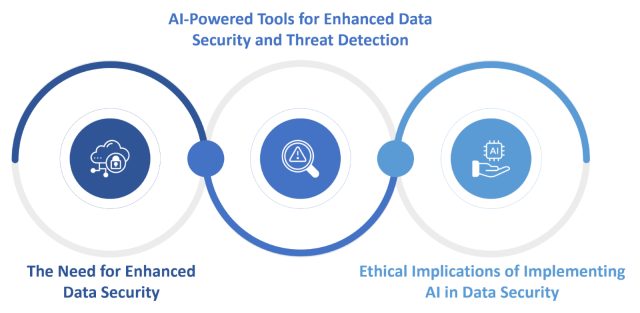Out of 194 countries, 137 have enacted core data protection laws to safeguard citizens’ privacy. With rising cases of data breaches placing Big Tech under scrutiny, enterprises of all sizes need to be more vigilant than ever.
Believe it or not, data breaches can be catastrophic. The effect can be so severe that it may impact millions or even billions at once. According to Cisco, 94% of organizations say their customers would not buy from them if they did not protect data properly.
In today’s digital age, data is a critical asset, but as data volumes grow and complexity increases, traditional protection methods fall short. To address this, organizations are turning to AI in data protection, relying on AI-driven data security solutions to improve threat detection, ensure compliance, and strengthen data privacy. This blog explores key applications of AI-powered security, real-world use cases, challenges, and emerging trends.
Leveraging AI for Robust Data Protection and Compliance
The digital era brings both innovation and risk. While data enables new possibilities, it also creates vulnerabilities that cybercriminals can exploit. AI plays a key role in strengthening cybersecurity, but its deployment must be ethical and well-governed. Read the blog to understand the role of cybersecurity in business continuity.
Download our latest industry report to gain more insights Top AI Trends 2025
Here’s an overview of how AI intersects with modern data protection:
- The Need for Enhanced Data Security
Frameworks like CCPA and GDPR demand robust safeguards. AI aids this by offering threat prediction, data access control, and anomaly detection—crucial components in AI-enabled cybersecurity frameworks.
- AI-Powered Tools for Enhanced Data Security and Threat Detection
AI doesn’t just detect threats in real time—it learns and evolves. By processing large datasets, AI systems can identify irregular patterns, anticipate attacks, and adapt to emerging risks. This allows businesses to stay ahead of attackers.
AI also enables:
– Automated data classification based on user roles
– Data masking and anonymization for secure sharing
– User activity monitoring to detect suspicious access attempts
- Ethical Implications of Implementing AI in Data Security
While powerful, AI must be used responsibly. Biased data can lead to discriminatory or flawed decisions. Explainable AI (XAI) is essential to ensure transparency and fairness in security protocols. AI systems must balance protection with individual privacy rights.
5 Powerful Applications of AI in Data Protection
Organizations face relentless data threats, making AI-based security tools essential. Here are five impactful uses of AI:

1. Anomaly Detection and Threat Prediction
AI can detect irregular behaviour in real time—from login attempts and network traffic to data access logs. By learning from historical attacks, it helps anticipate and mitigate future breaches.
2. Data Categorization and Access Control
AI automates the identification of PII, financial data, and other sensitive content. This helps enforce role-based access control, ensuring only authorized users access critical data.
3. Data Masking and Anonymization
Before storing or sharing, AI can anonymize or mask sensitive data, preserving utility while reducing exposure risk. This is vital for compliance and secure analytics.
4. User Behaviour Analysis
AI analyzes patterns in user activity logs to detect compromised accounts or insider threats. Real-time monitoring enables a swift response to unauthorized behaviour.
5. Continuous Learning for Evolving Threats
AI’s ability to learn continuously makes it an ever-improving defence system. It adapts to new threats, ensuring it remains effective in a dynamic cybersecurity landscape.
Future Trends in AI-Powered Data Protection
AI and cybersecurity are evolving rapidly. As AI technology evolves, we can anticipate that more innovative applications will emerge in the field of data security. Here are emerging trends shaping the future:

- Federated Learning for Enhanced Privacy
Federated learning enables training AI models across decentralized datasets, enhancing privacy by keeping data local. This is ideal for regulated industries handling sensitive information.
- Explainable AI (XAI) for Trustworthy Security
XAI improves transparency by clarifying how AI systems make decisions. It helps build trust, ensures regulatory compliance, and supports ethical implementation.
- Security Orchestration, Automation, and Response (SOAR)
AI-driven SOAR platforms enable automated incident response, reducing reaction time and improving defence strategy through adaptive learning.
- Human-AI Collaboration for Stronger Cybersecurity
AI assists security professionals with data insights, but human oversight remains vital for ethical decisions. Together, they create a more resilient data protection strategy.
Summary
AI offers a transformative opportunity for protecting digital assets. But to fully leverage AI, organizations must address challenges like bias, privacy concerns, and regulatory requirements.
Ongoing collaboration among engineers, ethicists, and policymakers is key. A responsible AI strategy ensures trust, compliance, and proactive cybersecurity. By following best practices, upholding ethical standards, and embracing transparency, enterprises can secure their data and earn stakeholder confidence in a world of evolving threats.
Frequently Asked Questions
Q1: How is AI used in data protection?
A. AI in data protection is used for real-time threat detection, data classification, anomaly monitoring, and automating access controls.
Q2: What are the benefits of AI in data security?
A. AI improves cybersecurity by enabling faster threat response, reducing human error, and ensuring data privacy through automation.
Q3: Can AI help with GDPR and CCPA compliance?
A. Yes, AI-powered tools automate data privacy workflows, classify sensitive data, and support GDPR and CCPA compliance.
Q3: What are the risks of using AI in cybersecurity?
A. Key risks include algorithmic bias, lack of transparency, and potential privacy concerns in AI-based security systems.
The post AI in Data Protection: Enhancing Cybersecurity & Ensuring Compliance appeared first on Calsoft Blog.


















